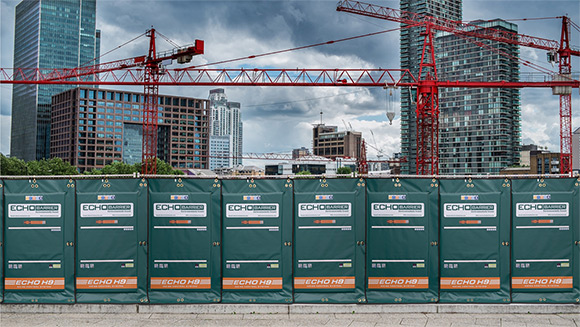
Revolutionizing Noise Control: High-Tech Echo Barriers Redefine Construction Site Soundscapes
Construction sites have long been known for their bustling activity, heavy machinery, and the constant symphony of sounds echoing through the urban landscape. For residents living in the vicinity of such sites, this cacophony can be a significant source of frustration and disturbance. To mitigate these noise-related challenges, traditional construction practices have leaned on heavy plywood barriers, often specified to meet a Sound Transmission Class (STC) rating of 30. However, a groundbreaking field trial has unveiled an alternative solution that typically provides around double the attenuation of these traditional barriers, heralding a new era of noise reduction technology: the Echo Barriers.
Questioning the STC 30 Myth
The STC 30 rating has long served as the gold standard for noise barriers, dictating that only materials with substantial mass can effectively attenuate sound. But is mass truly the only viable approach? The recent field trial demonstrated the limitations of this approach. The STC 30 test, originally designed to evaluate materials for fully enclosed rooms, does not accurately capture the performance of open site barriers. This leads to a paradox wherein the specification of a higher STC rating results in barriers that might be ineffective at attenuating noise in real-world construction scenarios.
Enter Echo Barriers, a lightweight and innovative solution that challenges the STC 30 myth head-on. By using a combination of high-tech materials, these barriers have demonstrated that they typically provide around double the attenuation of their old fashioned heavy plywood counterparts in a variety of settings.
Field Trial: Unveiling the Echo Barrier Advantage
The field trial, supported by independent acoustic consultancy AKRF Manhatten, sought to evaluate the efficacy of Echo Barriers against traditional plywood barriers in a typical real-world construction environment. Two adjacent 8-foot-high structures were set up, one adorned with the customary ¾” plywood barrier and the other with Echo Barriers. The tests involved a small jackhammer as the noise source, positioned at varying distances from the barriers.
The results were nothing short of remarkable. At a receiver height of 5 feet, the Echo Barriers exhibited an attenuation of up to 12dB, double the 9dB attenuation achieved by the plywood barrier. As the source of noise moved farther from the barriers, this disparity in performance only grew more pronounced. And that's not all – the trial introduced an additional element to the equation: a mobile Echo Barrier placed close to the noise source. This dynamic solution further bolstered the attenuation, culminating in an astonishing 18dB to 10dB increase, rendering the attenuation up to ten times more effective than the plywood barrier alone.
Unveiling a Quieter Future
The field trial not only presents a resounding case for the superiority of Echo Barriers in real-world construction settings but also opens the door to a paradigm shift in noise mitigation strategies. By breaking away from the shackles of the STC 30 paradigm, the construction industry can embrace lightweight, innovative solutions that are not just more effective but also offer the flexibility and adaptability required in today's dynamic urban landscape.
As cities continue to expand and evolve, the need for effective noise control becomes ever more critical. Echo Barriers, with their proven performance and technological innovation, promise to be an integral tool in shaping a quieter, more harmonious urban environment for residents, workers, and communities alike. With this groundbreaking field trial as evidence, it's clear that the future of noise reduction is lighter, more versatile, and full of promise.

